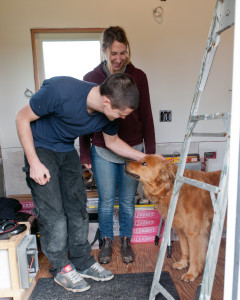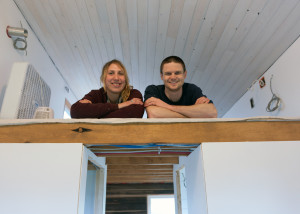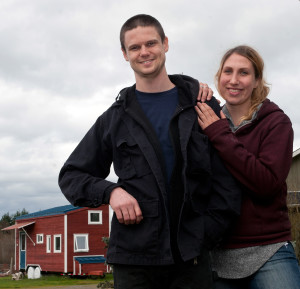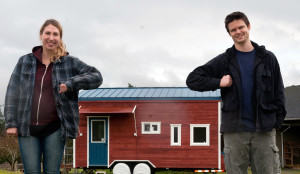Article and Photos by J. R. Rardon
When they began dreaming of moving from their small, one-bedroom apartment into their first real house, it’s unlikely Jake Stevenson and Kiva Ganie imagined it would involve downsizing.
But they’re about to do just that when they complete their foray into one of the biggest trends in home construction — the tiny house.
“We have been renting our entire adult lives,” says Stevenson, a 30-year-old journeyman electrician. “Regular houses just seemed like something out of our reach, but this tiny house concept seemed really appealing and felt like something we could really achieve.”
Their house, nearing completion on a rural farm owned by Ganie’s parents in Nanoose Bay, is built on the platform of an 8×20-foot custom trailer. Unlike a recreational vehicle, which is designed to reduce weight, the tiny house is made of traditional stud framing and boasts an insulated floor, separate shower and toilet/sink facilities, a kitchen, living room and loft bedroom large enough to accommodate a king-sized mattress, cabinets and an egress window.
All for less than the cost of a down payment on a traditional $300,000 ranch house.
The tiny house movement has become a sensation across North America in just the last few years, and is spreading around the globe.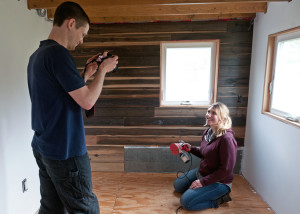
A BUSINESS OPPORTUNITY
Three years ago, Nanaimo’s Patrick Whelan could locate little information in Canada in his own effort to build a tiny house.
A year later, he founded Rewild Homes in Nanaimo, and in the last year the business expanded to include a second construction site for Rewild’s custom-built tiny houses.
“I decided I wanted to build a tiny home for myself,” says Whelan, who had been managing a small fishing lodge in Bamfield and thinking about what to do with the rest of his life. “I looked into it and found out there was not a lot going on in Canada. There just weren’t a lot of resources, but I felt this was a growing industry.”
Once family and friends got wind of his tiny house project, Whelan says, “the wake around me started getting turbulent. Everyone was asking, ‘Can you build me one?’ Having a background in construction, I wondered if there was a business opportunity in this.”
There may be several business opportunities.
Stevenson and Ganie, also 30, opted for a do-it-yourself home build, and turned their tiny house into a gargantuan project by taking their build to the public with a YouTube channel titled The Tiny Nest Project.
Launched in early 2014, before they had even secured the trailer upon which their tiny house would be built, The Tiny Nest project now has more than 13,000 subscribers and 33,000 views from around the world.
The 60-plus video installments uploaded has nearly one million combined views.
The good news: the YouTube channel actually provides the couple with income from its associated online advertising. The bad news: it has seriously cut into their construction time.
“My sister and her husband have a very successful kids’ YouTube channel, called Pancake Manor,” says Stevenson. “They were becoming more successful around the time we were discussing filming our (construction) footage and putting it on YouTube. “She was [like], ‘Of course! Yeah!’ Because that’s her thing.”
Stevenson and Ganie had mixed feelings, worrying that the documentary would cut into the time spent actually building the house. “Of course, we were both right,” Stevenson admits. “She was right that it could become something successful, and I was right in that it’s taken a lot of time away. I spend a lot of time editing video and doing other online tasks. In a way, that’s kind of my more full-time job.”
Stevenson and Ganie, who works at several area horse stables and at Parksville’s Cormie Farm, may well have stumbled onto a new career through their YouTube video project.
The channel’s videos, spread out over two years, show two people growing more and more comfortable, both with their building skills and with their on-camera presence, and Stevenson has ramped up the quality and special effects of the videos. One comment online, left in response to one of the videos, states: “Great job. You both should think about going into professional video creation and editing.”
“The original purpose of the videos was to have people watch and help us,” says Stevenson. “We had never built before, and when we were researching for this, there was no resource at that time on YouTube. We thought, if we do it, it’s a niche; it’s a market that’s out there.”
MAN CAVE OR DIVA DEN
Whelan said Stevenson and Ganie are a prime example of the demographic looking to build and move into tiny houses. But he says his customer base includes people at all stages of life.
“I have students, people just entering university who have some funding support from their parents…” Whelan explains. “There are also retirees and people just about ready to leave the workforce and people looking to downsize.”
Whelan says the portable, trailer-mounted tiny houses are also becoming popular as supplemental living/working spaces, for people running home-based businesses or who simply want a “man cave or diva den.”
Because the houses are portable, like a mobile home or an RV, they can be placed on many lots that would otherwise not permit the building of a second dwelling.
That will be the case for Stevenson and Ganie, whose new home will be placed on the acreage of the property owned by Kiva’s parents. The two have been living in the “big house” while building their tiny house right outside, and say the availability of the property was a major factor in their ability to move forward with the build after they spent much of the previous decade living in an apartment in Victoria.
“We were originally expecting to seek out and make a deal with someone in the Victoria area who had land and who would allow us to build,” says Jake. “That got to be a hot topic within the family.”
Ganie’s parents, meanwhile, had put their Nanoose Bay house and property on the market, but it was getting little action and they had decided to rent it out. Following a series of sit-down meetings and discussions between parents and children, it was decided that Stevenson and Ganie would rent the property while they completed their tiny house, then move in while Ganie’s parents returned to reclaim the main house.
“It was an absolute Godsend,” says Stevenson. “Because of how long this has taken, I don’t know what would have happened with the YouTube videos and stuff.
“And we would have had to carry our tools back and forth every day and set up (in Victoria),” Ganie added. “It’s really easy to just be right beside the house, with a garage for everything.”
SKIPPING THE QUEUE
The idea for their tiny house was born in 2013, after Ganie viewed the documentary We, the Tiny House People while taking classes at the University of Victoria. Until then, the young couple had essentially resigned themselves to a lifetime of apartment living. And that’s when the tiny house opened another door.
“At 22 (years old), we weren’t thinking about a house. At that age you just sort of think it will happen in the natural course of living your life,” says Stevenson. “But now we were almost 30 and didn’t feel we were getting any closer to that. We thought we could explore this (tiny house) alternative, which would let us skip the queue.”
Photos: Kiva Ganie and Jake Stevenson stand in front of their Tiny House in Nanoose Bay. Kiva and Jake inside their Tiny House with their dog Ben.
To learn more about Jake and Kiva’s project and to link to their YouTube channel, visit
www.tinynestproject.com.
To explore custom tiny house options at Rewild Homes, visit www.rewildhomes.com.
